The concept of sustainable architecture is evolving, with a growing focus on integrating circular economy principles to create environmentally friendly and efficient buildings. As the world's population continues to grow and urbanization expands, the construction industry faces both challenges and opportunities in adopting circular economy concepts to promote sustainable building practices.
Challenges
Lack of Awareness and Understanding: One of the primary challenges in integrating circular economy principles in sustainable architecture is the lack of awareness and understanding among architects, builders, and stakeholders. Many in the industry are unfamiliar with the concept of circular economy and the potential benefits it can offer.
Financial Constraints: Another challenge is the perceived cost of implementing circular economy practices. Some stakeholders may view sustainable materials and construction methods as more expensive, leading to reluctance in adopting these principles.
Complexities of Design and Construction: Designing and constructing buildings with circular economy principles in mind can present complex challenges. The need to use recycled materials, design for disassembly, and consider the entire lifecycle of the building requires a shift in traditional architectural practices.
Opportunities
Resource Efficiency: Embracing circular economy principles in sustainable architecture presents opportunities for resource efficiency. By using recycled materials and designing for disassembly, buildings can minimize waste and contribute to a more sustainable use of resources.
Innovation in Material Choices: Integrating circular economy concepts encourages innovation in material choices. This opens up opportunities for architects and builders to explore new, sustainable materials that align with circular economy principles.
Positive Environmental Impact: Sustainable architecture with circular economy principles can have a positive environmental impact by reducing carbon emissions, minimizing waste, and promoting a more sustainable built environment.
Conclusion
Integrating circular economy principles in sustainable architecture presents both challenges and opportunities for the industry. Overcoming the barriers of awareness, cost, and complexity will require collaboration and innovation. However, the potential for resource efficiency, innovation, and a positive environmental impact makes the integration of circular economy principles an exciting and important aspect of green and sustainable architecture.





























































